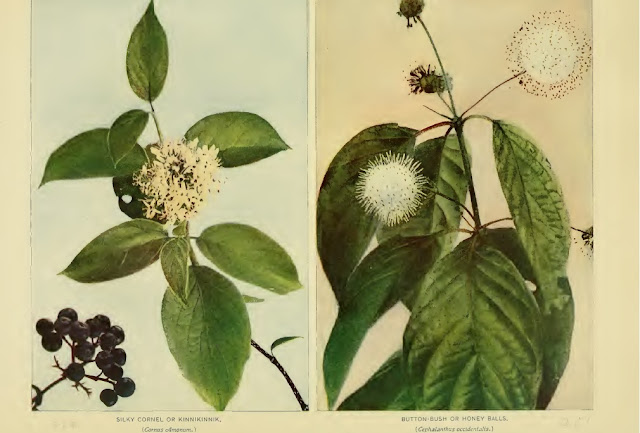Last week, on the 29th, I was coming back in after a day in the field at the UC-Davis McLaughlin Reserve (in Lake County, CA) where I do all my work. I was setting up some insects in containers in the building when some one from next door came over to point out a smoke plume rising NW of the reserve.
 |
| I wonder if this is the first photo of the Rocky Fire... it was taken at either 4:01 PM, Cal Fire says it started at 3:29, a few miles NW of the reserve. |
Within a few minutes, it was obvious that this wasn't going to be like the other, smaller fires that were put out quickly the week before in the same area. I continued doing my work and made dinner. I wasn't particularly concerned, since the wind was pushing towards the fire and the plume was making its way away. By nightfall, it got worse, and the wind began to shift.
 |
| 7:57 PM and the smoke plume still moving away from us. |
At this time, I went next door to the mining building to hang out with the safety guy there, who was on site in case this caused any problems for them. By 10ish, the power had gone out, the wind had come around and there was smoke and a small amount of ash falling. By 11, CalFire had shown up and told us it had jumped the road and that we were going to be evacuated soon. I packed up a few clothes, my bug nets, computer and a little bit of food and was on the road by midnight and back in Davis a little before 3 AM (nearly hitting a deer in the process). I fully expected to be back in a day or two. I had planned to stay there for a couple weeks - my longest continuous trip of the summer - as both the tarweeds and the columbines are in the middle of their season in late July/early August.
 |
| Navarretia mellita, the subject of one of my experiments, which was going along swimmingly before I left. |
After the evacuation and my near deer miss, I was running on a bit of adrenaline... I got to sleep by 4 AM or so and was up again by seven. And I spent the better part of the following week that I was evacuated refreshing the CalFire website as the fire grew in waves until nearly 70,000 acres (that is ~110 square miles). My sites all lay pretty much on the fire perimeter - I had no idea what to expect until I got back, as I knew that fires burned patchily.
Doing small-scale insect-plant interactions, I do my experiments on a plant-scale - manipulating traits of one plant, and I mostly work on annuals and all on a yearly basis (which means I can't do a pre-/post-fire comparison). I do many experiments each season - this year I was running 7 at the time of the fire - all in the northern and western parts of the reserve, where the fire was most intense. So my heart was racing the whole trip back, when I was allowed in on Thursday (the 6th - over a week after evacuation). I dropped some refrigerated stuff off and quickly hurried out to my sites...
 |
| This is the wet meadow where my recently published experiment took place and where I had another experiment going this year. |
As I drove in to my columbine experiment, I knew it wasn't going to be a pretty sight. You can still see a streambed on the left side. Surrounding it was a nice population of serpentine columbine (
Aquilegia eximia), hedge-nettle (
Stachys albens) and common monkeyflower (
Mimulus guttatus) with a scattered coffeeberrry (
Rhamnus sp.) and willow (
Salix sp.), bordered by THICK chaparral (manzanitas, oaks, chamise, etc.). I did find remnants of the experiment...
 |
| I should have bought the pin flags rated for raging-wildfire temperatures. Next time. |
My next experiment was through a tiny circuitous trail which I had carefully machete hacked earlier in the season through manzanita and cypress. It involved going over and under a number of logs and around small breaks in the chaparral. Yesterday I could walk (and see) in a straight line through a whole lot of nothing. All I found was a tiny bit of melted flagging tape, attached to a columbine stalk that had somehow escaped total incineration...
 |
| Based on its location (and most of my landmark shrubs were gone), I think this was control #50. It formerly was under a manzanita. I found it in the middle of a large, barren field. |
All was not lost, however! My next project was a huge set of experiments examining defensive induction in a tarweed,
Hemizonia congesta (this specific epitaph is accurate, at least for me). Fire fighters had made a dozer line through the upper end of this field between two roads. The flames reached the two roads and the firebreak, but fortunately never jumped and my site (containing 250 plants which I had been following for months), ~200 meters beyond, remained intact. I was a bit worried that perhaps the insects would have been affected, but the insect communities seemed normal in abundance and identity.
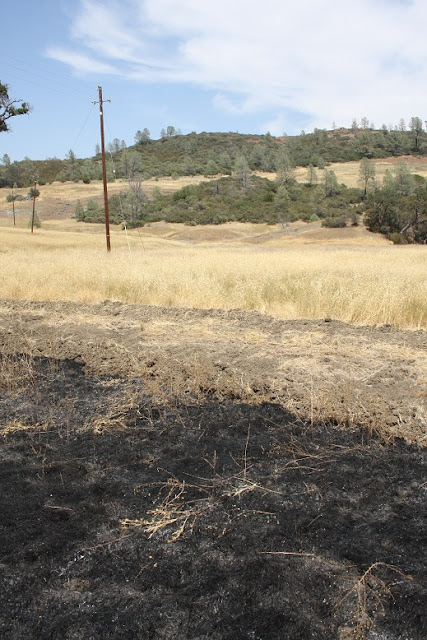 |
| My site is on the middle hump in the mid-ground. You can see the sparse vegetation on those serpentine barrens compared to the field of Avena in the non-serpentine areas. |
The grasslands were wild to walk around. Grass fires don't burn as hot nor for as long as chaparral fires, so some things survived. Not among those surviving were the rabbit-poop looking burnt star thistle flowers and fruit.
 |
| It burned the spines right off the thistle flowers. And it looked like most hadn't seeded... hooray! |
 |
| The living stuff on the right is a variety of tarweeds (Hemizonia, Holocarpha and Calycedinia spp.) growing on a serpentine barren (low biomass). The burned area on the left was Avena and star thistle and had much higher biomass and apparently burns better. |
 |
| Like the wicked witch of the west when confronted with water, milkweeds (this is Asclepias eriocarpa) apparently just melt in the face of fire. |
 |
| Not all the milkeeds melted, fortunately for this large monarch caterpillar (and the orange oleander aphids out of focus in the foreground). There were a bunch on a small surviving patch of Asclepias fascicularis which was no more than 2 meters from completely scorched earth. I wonder whether they emigrated here from melted plants or if they were all on the one patch to begin with. |
The grassy areas had tons of Mourning Doves. More than I've ever seen at one time in my life. Did they group up after the fire and emigrate right to my field site? I don't have a clue. I usually see them near
Croton (
Eremocarpus)
setigerus, but that's not around this site - I wonder if they were eating burned thistle heads or other seeds exposed by the burning of all the grass.
 |
| The patchiness of the fire on a microscale was crazy. Here a small patch of seeding Mimulus nudatus (a rare California endemic found only in serpentine soils in a small part of the northern coast range) stands amidst a scorched landscape. |
Another set of experiments I had were also very close to a burned area, but they too, were spared. I was studying the ecology of two sticky species:
Navarretia mellita and
Madia elegans. Both are weedy species that love disturbance. There is an old road above the center that is drive-able, but rarely driven and hosts nice populations of both species that like the roadside disturbance. The
Navarretia experiment was pretty much fine, being about 5 yards from the road. In the couple weeks that I hadn't checked it, some of the seeds had dehisced, but I had final inflorescence number for all the plants, which is enough of a fitness proxy for my purposes.
 |
| Big flags, little tiny plants. |
The tarweed (
Madia elegans), on the other hand, suffered a little bit. During the fire, trucks must have driven by that site hundreds and hundreds of times... I was there for the afternoon yesterday and had 4 or 5 cars drive by twice each (it is a dead-end) - and that was long after the fire was out in that section. Tarweeds are sticky and I was manipulating the amount of insects they caught (following up on Billy and Ian's
Madia study and my columbine study). Most of the plants were within a yard of the road edge (non were on the road - none got hit), but with the hundreds of vehicle passes the amount of dirt kicked up and subsequently caught by the tarweeds was crazy. The treatments - varying amounts of dead fruit flies - were sort-of intact, but redoing the treatments was a major trial, as the fruit flies wouldn't stick. This will get better as they grow and they ought to flower for another month or so, so perhaps this won't be a complete wash... we'll see.
 |
| Its hard to see in this picture, but pretty much every glandular trichome on the plant had dust stuck to it, rendering it pretty much completely unsticky. |
The last experiment, a manzanita fruit manipulation, had pretty much been doomed from the get-go. I started the experiment early in the season, when the plants thought they had lots of water, but soon after, they aborted all the fruit I had in the experiment. So I moved to a new site, on the edge of a pond, where the shrubs were a little bit happier, but I started it too late (as I was still nursing the first try along a little bit). The fire left only one of those manzanitas standing at all as it whipped around the pond. Not a huge loss, though it would have been nice to get the last set of data.
 |
| A dead deer in the pond that the manzanitas were next to. I don't know for sure that this was fire related, but it seems likely as the chaparral up to this pond on three sides was burned completely for hundreds and hundreds of meters. |
In the pond, besides the dead deer pictured above, life seemed to go on fine. The tule and cattails were intact, as good, water-filled greenery should be. Pied-billed grebes continued to feed streaky little babies and coot made all their funny noises. I finally saw the first Ruddy Duck baby of the year - in years past there have been quite a few in this pond and this year there were quite a few pairs, but only one duckling seems to have come out. A Gadwall nest that I found a few weeks back should have hatched (or been preyed upon by coyotes, raccoons, etc., by now) and a few rather large babies were around the pond, along with the first Green-winged Teal of the season. Tiger beetles ran on the shores and dragonflies flitted by, as if nothing had happened.
 |
| I'm not sure where this jackrabbit fled during the fire, but he's a survivor for sure - there wasn't much unparched in the area that I found him. There were a good number of these around - and strikingly, in a lone patch of Garrya, with literally nothing for hundreds of yards around, a chipmunk scolded me! |
 |
| Other folks lost experiments as well. This was a bird exclosure, under which was a chamise that had been monitored for years. |
The amount of life around, even in burned areas just a week later was astounding. While exploring, I heard a pair of Rufous-Crowned Sparrows chipping from a couple mostly demolished manzanitas along a completely devegetated streambed. They popped out to check me out - I suspect that most territorial animals are dealing with a lot of stragglers coming by. I had a secondhand report of a mountain lion wandering down a road near fire crews in the middle of the day - not a typical behavior. While watching sandpipers, I heard a barking, like that of a large dog coming from near where my truck was parked. Thinking it might be a lost dog displaced by the fire, I headed towards it. As I neared the truck, on a rock above it was a coyote, looking down at me and barking like hell. As I fumbled in my backpack for my camera, he ducked behind the rock and continued berating me until I left.
 |
| Walking through dense manzanita chaparral is miserable. Walking through the same area now is quite easy. |
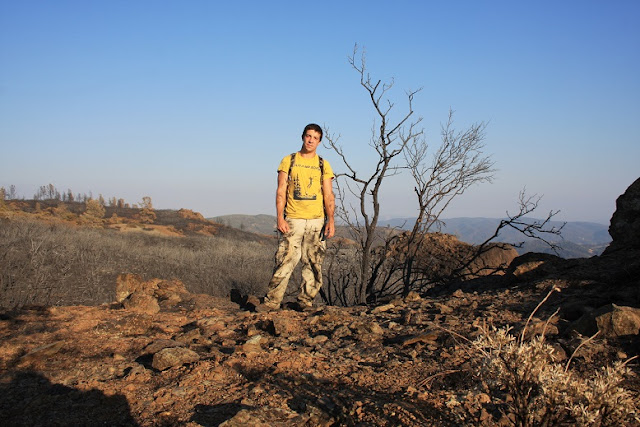 |
| Though it makes you quite dirty. This was after only about 10 minutes. After an afternoon of hiking around, I looked like a coal miner. |
For a number of reasons, I spend a bit of time looking at spiders: they are important predators on many plants, I've worked on crab spider behavior, and much of the Bahamian island research revolves around them. One of the first signs of life in the fire area was funnel web spider (Agelenidae) webs, which are a thick mat of webbing with hole the size of a nickel or so (like a funnel, as the name suggests). There were tons of them on top of the blacked dirt and vegetation.
 |
| A nice clean, fresh, funnel web on top of blackened soil. |
In contrast, in non-burned areas, the webs were messy with ash that was clearly flying in large quantities with the fire nearby. I wondered why the spiders hadn't spun a new web or cleaned it out. I suspect that the reason has to do with how costly spider silk is to the spider. Being made of protein and laid out carefully, it is both nutritionally costly and time-intensive to make a web. Many spiders eat their webs if they take them down and there is even a group of parasitic spiders which eat the webs that other spiders make (!!!).
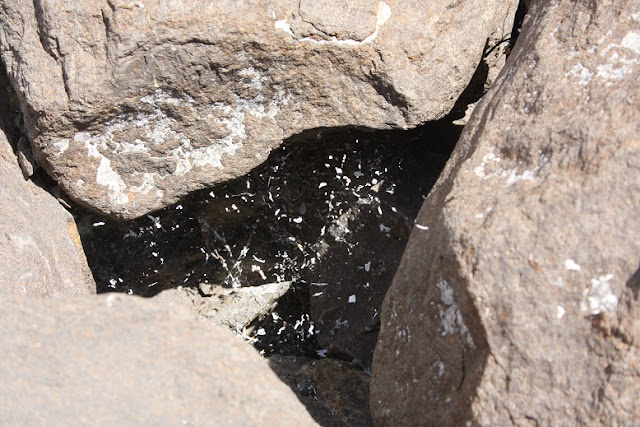 |
| A web with lots of entrapped ash. I think it is a theridiid, but I didn't look too closely. All the webs were covered like this. |
 |
| Pocket gophers also survived, with fresh diggings in the 5 or so days since the fire passed through this area. I just saw my first pocket gopher a few weeks ago, while being acquainted with their diggings for years. They have really, really weird ears. |
Its been a really interesting time to look at the natural history of this area. The next few years, while I continue my phd, will also be an interesting time of watching fire-following plants, resprouters and who knows what else.
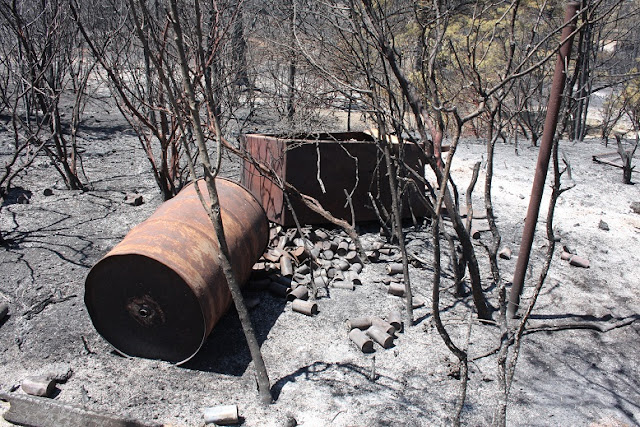 |
The fire opened up previously hidden scenes from dense chaparral, like this midden. I guess this was from when there was a nearby shale quarry operating, but I'm not sure. Those beer cans look old...
|
AND THEN...
I wrote most of this the night of 8/8/15. About 4 PM today (8/9/15), another call came on the radio about a smoke plume. I hurried outside and shit... another BIG fire, within a couple miles, this time SW of the station. This one has been termed the Jerusalem fire. I hurried and collected some seeds for a friend and reconned some badly dozered sections in the SE portion of the reserve.
 |
| Jerusalem fire, ~4:30 PM, 8/9/15. If the twittosphere is to be believed, those two plumes are from two separate arson fires. |
 |
| These dozer lines are ridiculous. There are at least 4 (and a road) between this particular one and anywhere the Rocky fire actually burned. They tore the shit out of some really nice oak woodland habitat and compacted soil, etc. |
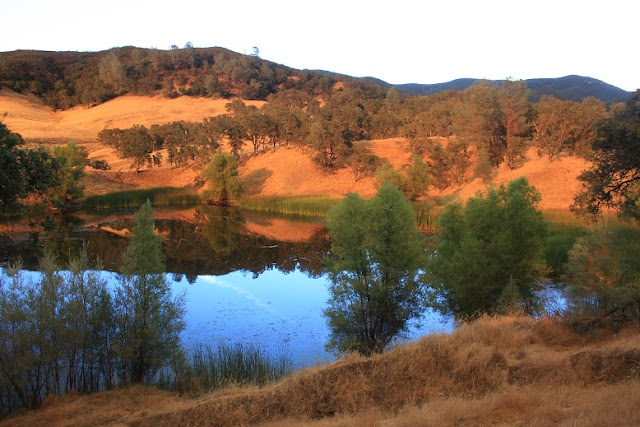 |
| Fire haze does produce extremely beautiful light. |
 |
| This charred live oak (?) leaf was one of many which rained down during my hike... the fire was 3-5 miles away at this point. |
 |
| Like ecologists, firefighters seem to like to put flagging tape on anything interesting. Here on abandoned machinery. Its also on gates, fences, various poles, etc. |
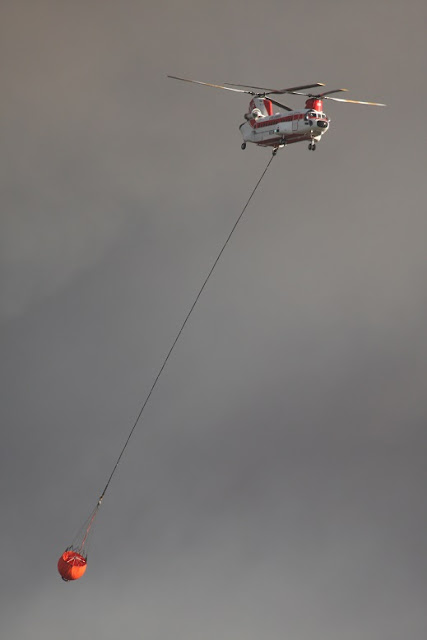 |
| A constant part of the wildlife now, these big birds are really thirsty, sometimes drinking 3,000 gallons every few minutes. I'm getting better at my identification of these. I think this is a Boeing 234 "Chinook", but these two rotor helicopters seem almost as confusing as empid flycatchers... field guide.here. |
We'll see how this one pans out... I'm not particularly worried for my experiments now. If they burn, they burn but there is a lot of burned area between this one and them (it is continuous, but the fire would need to turn a couple different ways before it got to anything).
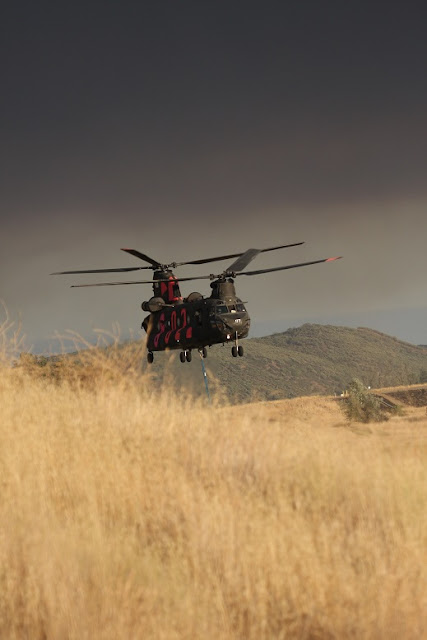 |
| The pond this CH-47 just refilled from is part of the complex where the field component of this paper took place. |
I did learn some field season lessons, as well.
Things I will do differently next summer:
1) Space my experiments out farther! The farther apart they are, the more likely a fire line will go between them in case something like this happens again.
2) Put them a little farther back from roads (this also would protect against accidental drive-overs).
3) Put them in a matrix of previously burned areas. Its hard to reburn the same areas two years in a row (though the Wragg fire managed that this year in Yolo/Solano counties!). That will allow a little extra safety.
And finally - while I lost some work (a couple months on a couple projects), I'll certainly be able to repeat those next year and I'll get a couple completed experiments from the seaon. Thankfully, I didn't lose my house, my pets, my vehicles or my livelihood - others did.
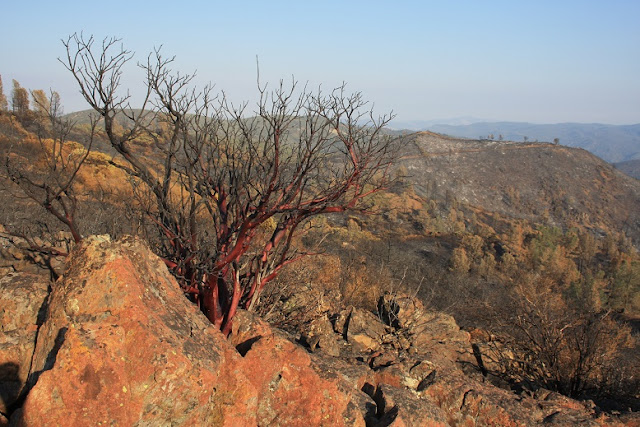 |
| A lone manzanita looks out over a burned land. The road you can see in the back right is Roundtop road, in Knoxville Recreation area. It would be a good place to check this out from (but do not, under any circumstances, camp in the campground there). I guess the area to the right all has already/will burn in the Jerusalem fire, too. |











